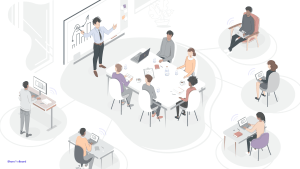Remote whiteboarding
You no longer have to pick one or the other
Many of us work remotely. We're willing to bet that many of you do too. And those of you who work in an office most likely work with colleagues, clients, and companies sitting in other offices. In a nutshell: if you do anything that is now or ever was done in an office, odds are you're "working remotely" for at least some portion of the day.
Many of us enjoy a good whiteboarding session. There is something timeless and powerful about the whiteboard as a tool. Observe:
- For one, the whiteboard requires no instruction. It relies on skills so innate - writing, drawing, scribbling, pointing - you could say it's instantly intuitive.
- For another, its size and ease of use allow us to use those innate skills without reservation. More: it almost encourages a brazenness and creative recklessness otherwise reserved for childhood.
- Thirdly, these powers appear directly correlated to the number of simultaneous users it serves. The more people use it, the better - how many tools can say that?
The result? A simple, instinctual tool that encourages ingenuity and collaboration at the speed of thought. Awesome.

Now ask yourself when was the last time you successfully combined remote work with whiteboarding? If you're like any of the few hundred organizations we've spoken to on the subject, the answer is most likely "never."
Up until now, you've had to use one of several unideal alternatives when attempting to whiteboard remotely:
- You could use digital solutions (e.g., virtual whiteboards) - but these just don't draw out the same creative juices that a traditional whiteboard does. Even if a work area is virtually never-ending, its visual scope is still limited by your screen. And no touchpad will ever outdo a whiteboard marker for writing comfort.
- You could use hardware solutions (e.g., touchscreens) - but again, even the best touchscreen doesn't provide that natural, haptic feedback to which we're accustomed. Moreover, hardware solutions are expensive, unscalable, and decidedly immobile. If you need them anywhere other than that one room, you're out of luck.
- You could use video conferencing - but if you've ever had the, um, pleasure of looking at a whiteboard as a remote participant, you'll know that this is no solution. The content is illegible, the angle is often awkward, any your colleagues are often in the way.
- You could fly everyone in - you'll be surprised at how often this answer came up. Many teams will spring for airfare, carfare, and lodging for several teammates, in order to conduct a successful planning or brainstorming session. Of course, the costs of such a maneuver are prohibitive for many companies and much could be said about its environmental impact. Besides, if you forgot something during your time together, you're back to one of the other options.
- You could do nothing - this one also appeared somewhere on everyone's list. Put simply: whiteboarding was sacrificed at the altar of remote work. You just couldn't do it.
To the above one could add the sporadic - though, again, not that rare - efforts of individuals to engage their remote colleagues: stacking books on a desk and placing a laptop/camera on top, or taking smartphone photos of the board every few minutes and sending them out. These are at least inefficient and at most a disturbance and security nightmare.
What's to be done?
Despair not, fellow remote workers. For now, there is a true remote whiteboarding solution.
Our latest and greatest pride and joy, ShareTheBoard, offers a solid step in the direction of true visual collaboration for distributed teams. What makes it so different? Simple: rather than attempting to replicate the natural awesomeness of whiteboards, we're working to give those creative extractors new skills. Rather than requiring users to learn new tools/techniques, we believe that technology should do the heavy lifting.
Put plainly: we believe that you should be able to whiteboard on a whiteboard and your remote participants should not have to complain about legibility or feel excluded. We believe that anything written on a whiteboard should be shareable without creating potential security threats. Moreover, we believe that doing this should be possible without breaking the bank and without tethering oneself to one room - isn't that the whole point of, you know, being remote?
ShareTheBoard is a pioneer in a developing category of remote whiteboarding tools. Our application is intelligent enough to distinguish handwritten content from background or foreground/obstacles. It can amplify that identified content to ensure its legibility and make obstacles appear transparent, to minimize disruption. It can even give remote participants the ability to contribute content (at first digitally but soon, through the magic of AR, directly on the board). Best of all, it can do all of this using those ubiquitous tools which surround us every day: the very mobile laptop and the even more mobile smartphone.

The next time someone tells you that remote whiteboarding can't be done, steer them our way. Better yet, steer them toward ShareTheBoard. There they'll find a free trial for a potentially life-changing tool. OK, maybe that's too far but if they're anything like us they'll be thrilled to finally combine remote work with one of the best tools ever made.
Thoughts? Suggestions? Criticisms? Let us know. And if you are one of those thrilled folks, please reach out to us. We love to hear from fellow whiteboard-philes!
